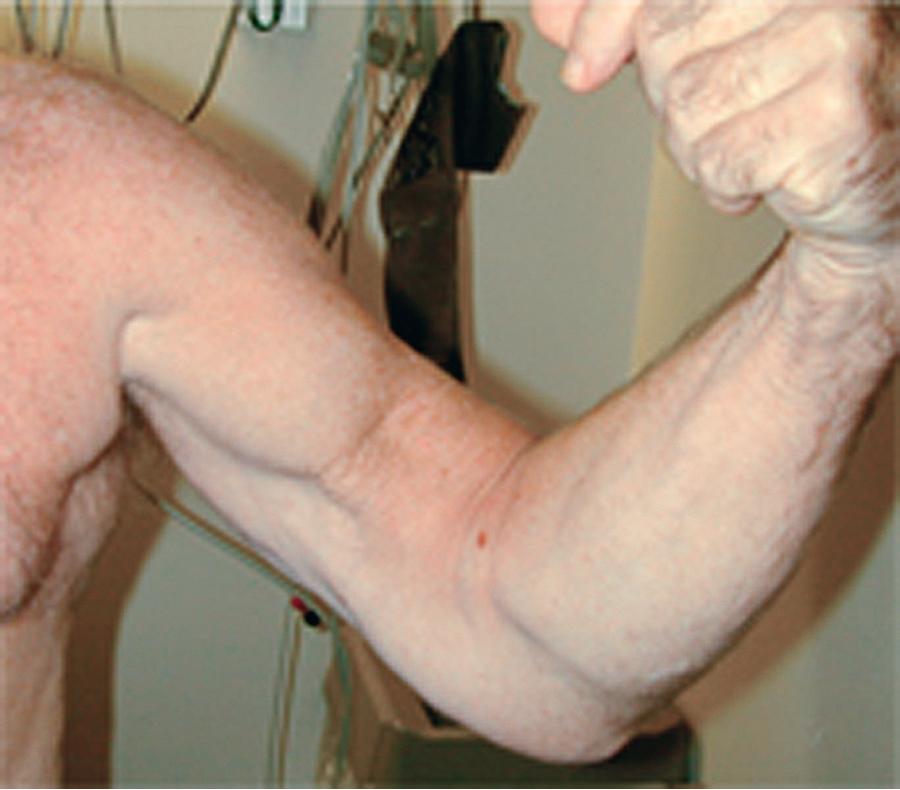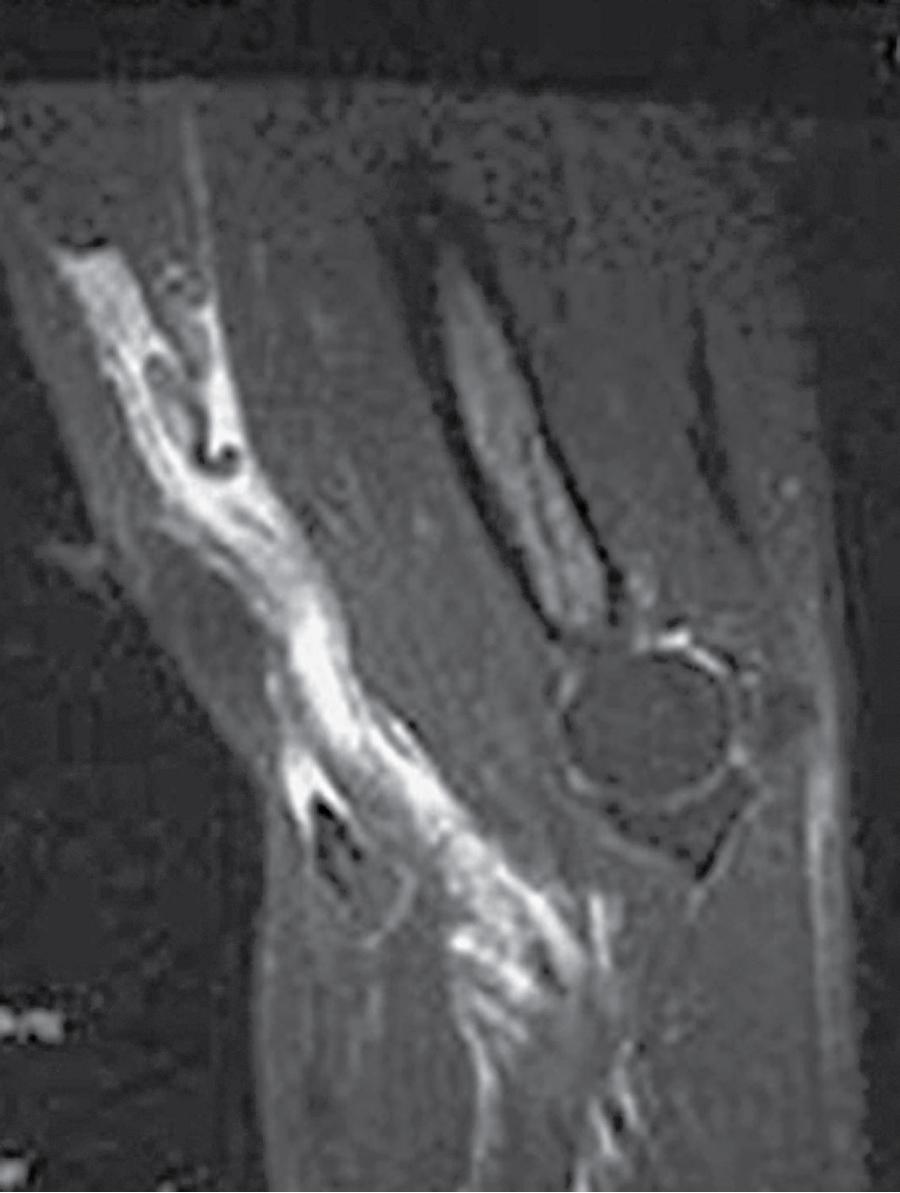Physical Address
304 North Cardinal St.
Dorchester Center, MA 02124
This chapter describes the technique for completing a distal biceps brachii tendon repair and provides an overview of the contemporary results.
There are two predominant methods to repair the distal biceps: the one-incision and the two-incision techniques.
The one-incision technique is described in detail in this chapter. The theoretical benefit is a less-invasive approach with the added risk of dissection in the anterior elbow.
The two-incision approach has traditionally been described as carrying a higher risk of heterotopic ossification and is a larger approach. However, recent research has shown low rates of heterotopic ossification with newer techniques.
It is essential to identify and protect the lateral antebrachial cutaneous nerve.
The biceps tendon should be placed on the ulnar side of the radial tuberosity.
The supine position with a radiolucent hand table is used.
A transverse incision is made at the distal aspect of the flexion crease in the elbow with an L component that overlies the brachioradialis; this can also be extended proximally if needed with a vertical component on the medial aspect of the arm.
After incision, identify the lateral antebrachial cutaneous nerve. Injury to the nerve can cause paresthesias in the forearm.
The biceps tendon may be retracted proximally.
During exposure of the radial tuberosity, the arm should be in supination to protect the posterior interosseus nerve.
Injury to the lateral antebrachial cutaneous nerve can result in paresthesias in the forearm.
Injury to the posterior interosseus nerve can cause significant functional complications.
There can be many recurrent vessels from the radial artery in the field of exposure. These should be meticulously coagulated to prevent postoperative bleeding.
The distal insertion of the biceps brachii tendon ruptures infrequently, with an incidence of 1.2 cases per 100,000 person-years. Proximal tendon ruptures are far more common, accounting for 97% of all biceps tendon ruptures. However, when distal ruptures do occur, they affect the dominant arms of highly active men aged 40 to 60 years and can be associated with substantial functional and financial disability due to chronic pain and weakness in forearm with supination and elbow flexion. ,
Although nonoperative treatment , and tenodesis to the brachialis originally were suggested as treatment options for distal biceps ruptures, anatomic reconstruction with repair of the biceps to the bicipital tuberosity on the proximal radius has led to excellent functional outcomes, high patient satisfaction, and restoration of strength and endurance in forearm supination and elbow flexion in numerous clinical series. Boyd and Anderson’s original description of such a repair involved two incisions and fixation via an osseous bridge. However, whereas injury to the posterior interosseous nerve (PIN) may have been decreased with this technique, this method led to an unacceptably high incidence of heterotopic ossification and synostosis of the radius and ulna. , , , Thus, the anterior, single-incision procedure has risen in popularity. , , , Fixation methods have also evolved, first with the use of suture anchors , and more recently with a cortical suture button. , , , The cortical suture button has been demonstrated to be biomechanically superior to suture anchors by at least a factor of two, and to an osseous bridge by a factor of three. This technique also allows suture tendon “prefabrication” outside of the wound. An array of cortical buttons are now available through multiple vendors, and some advocate for a combined approach utilizing a cortical button alongside an interference screw. This technique has demonstrated decreased gap formation with the addition of an interference screw. In addition to success with repair of acute lesions, good outcomes have also been demonstrated in the repair of chronic ruptures with an allograft bridge between the shortened tendon and the anatomic insertion. , ,
Distal biceps tendon ruptures most frequently occur in the dominant extremity in men aged 40 to 60 years after a sudden eccentric extension load on an unsuspecting flexed elbow. At the time of injury, patients commonly report a ripping sensation or a sudden “snap” in the anterior elbow with progressively worsening anterior elbow pain. Over the course of hours to days, edema and skin discoloration caused by subcutaneous hemorrhage develop. The presence of significant ecchymosis implies concomitant rupture of the lacertus fibrosus, which allows extravasation of blood from the rupture site into the subcutaneous tissues. Untreated, the patient may then develop pain in the anterior elbow with activities associated with repetitive or forceful elbow flexion or forearm supination with associated weakness in these movements. However, patient presentation is variable, and a complete constellation of findings is present only in a minority of patients.
Whereas complete ruptures are more common, some injuries may have residual continuity of the tendon. Although similar in symptomatology, these “partial” injuries are considerably more difficult to diagnose and rely on advanced imaging modalities, such as magnetic resonance imaging (MRI). Partial rupture exists on a spectrum with several poorly understood diagnoses including cubital bursitis, bicipital tendinosis, and biceps paratendinitis, each of which can exist in isolation or can coexist with a distal biceps tendon rupture.
In the acutely ruptured distal biceps tendon, the examiner may observe diffuse swelling and ecchymosis radiating from the antecubital fossa. Acutely, guarding caused by pain may make provocative testing difficult. Once the acute inflammation has resolved, the patient may notice a change in the contour of the arm ( Fig. 56.1 ), resulting from proximal retraction of the biceps.

Several physical examination maneuvers rely on palpation of the distal biceps tendon. The examiner may be able to palpate a defect within the tendon by attempting to “hook” an index finger around the distal biceps tendon in the flexed and supinated arm. This “hook” sign can be more difficult to elicit if the lacertus fibrosus remains intact. While palpating, the examiner can then supinate and pronate the patient’s arm with the other hand, which should cause proximal and distal movement, respectively, of the junction of the distal biceps tendon and the biceps muscle belly. If no motion of this junction can be appreciated with forearm rotation, the examiner should consider a distal biceps rupture. In a similar test of the “tenodesis effect” of the tendon distally and the muscle belly proximally, the examiner may manually compress the biceps muscle with the arm relaxed in 90 degrees of elbow flexion and neutral forearm rotation to slight pronation to place the biceps muscle under tension. This “squeeze” should cause an obligate supination of the forearm, analogous to the Thompson test in the calf for Achilles tendon rupture. This test has been shown to have a high sensitivity and a low false-positive rate, although its specificity is yet to be undetermined.
Whereas active resisted forearm supination and elbow flexion will often be objectively weak compared with the contralateral uninjured side, a lack of weakness does not exclude tendon rupture because other muscles—such as the supinator and brachialis—can also account for these motions.
Radiographic imaging infrequently contributes to the diagnosis, although obtaining anteroposterior, lateral, and oblique views is crucial for exclusion of other osseous pathology. In addition, radial tuberosity avulsion fractures can have a similar presentation, and therefore the examiner must scrutinize the images closely for this easily missed diagnosis. With chronic distal biceps tendon ruptures, the radial tuberosity may undergo hypertrophic changes.
In patients in whom the history and physical examination findings clearly suggest a diagnosis of distal biceps tendon rupture, no further imaging is needed. However, MRI can be helpful when the diagnosis is unclear or when a partial rupture is suspected. , These images can also aid surgical planning, especially in the setting of a subacute or chronic tear, because a proximal rupture may indicate a more proximal approach. Common MRI findings include discontinuity of the tendon with distal absence, increased T2 signal in the sheath indicating inflammatory fluid, increased T2 signal within the muscle, and a mass within the antecubital fossa resulting from the retracted proximal tendon end ( Fig. 56.2 ). In a more chronic setting, atrophy of the biceps muscle may be seen, as well as thickening of the remainder of the tendon. , Because this tendon does not travel in the traditionally defined anatomic axes, MRI in the flexed, abducted, and supinated position can be a useful adjunct. In the setting of a partial tear, MRI can be used to determine the extent of the tear. MRI may lack sensitivity and not correlate with intraoperative findings. In persistently symptomatic patients with strong clinical findings, MRI should be used as an adjunct to decide the course of treatment. Anecdotally, intraoperative findings have revealed larger tears than otherwise appreciated on MRI. MRI can also be useful to assess for associated pathologies such as bicipital tendinosis, bursitis, paratendinitis, hematoma, or contusion. Ultrasound may play a role in diagnosis owing to its cost-effectiveness and reliability. However, this technique is operator-dependent and thus continues to be institution-specific.

Become a Clinical Tree membership for Full access and enjoy Unlimited articles
If you are a member. Log in here